When John Pierpoint Morgan’s bankers stepped into their hallowed Wall Street headquarters, they probably stood a little straighter.
The marble-clad triangular edifice, opposite the New York Stock Exchange, was an august temple to capitalism: a year after its 1913 completion, Real Estate Record and Guide marveled that the building was ‘a rival to the Parthenon.’
Today, descendants of those same financiers are walking into a very different world.
This month JPMorgan Chase, as it’s now known – the world’s largest bank, by market capitalization – moved into its new headquarters. And it’s one that would make John Pierpoint’s head spin.
The $3 billion 60-floor tower, a stone’s throw north of Grand Central station, stretches half a mile into the sky and is home to 10,000 workers. Facial recognition scanners or fingerprint detectors assess each arrival, ushering employees to their correct workstation through banks of high-speed elevators.
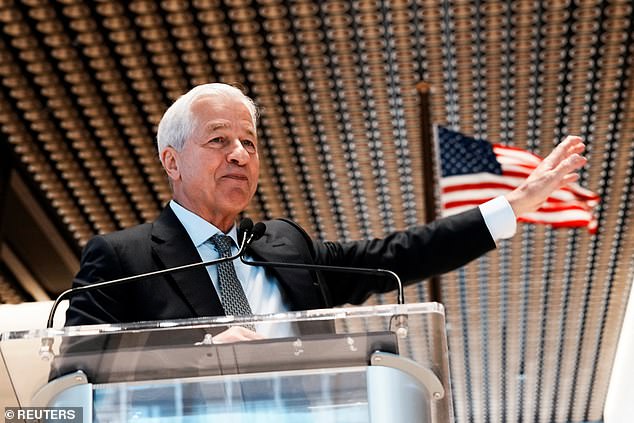
Jamie Dimon, CEO of JPMorgan Chase, is seen at the October 21 opening of his new HQ
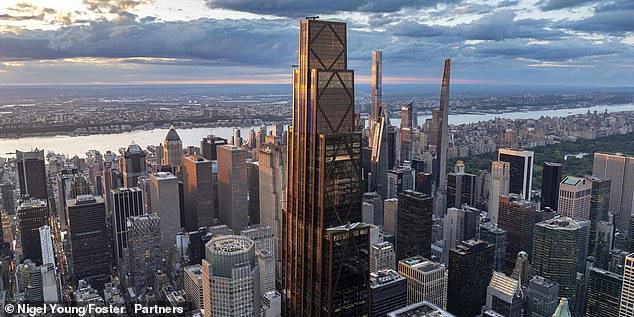
The 60-story office, at 270 Park Avenue, is the sixth tallest building in New York City
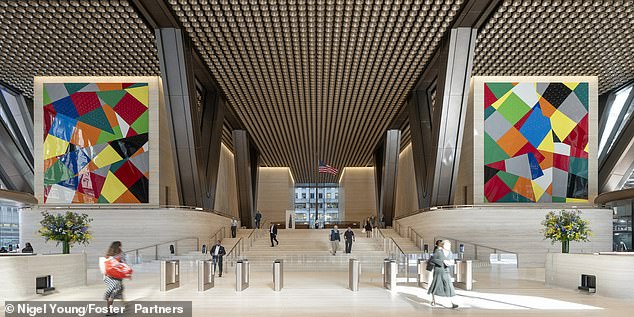
The entrance to JPMorgan’s new $3 billion office, with its facial recognition entry system
If you stop for a coffee on entering, the cafe already knows your usual order. Sit at your desk, and artificial intelligence guides the blinds on the windows. Book a meeting room, and the temperature will adjust to your preference. Feeling hungry? One of 19 restaurants inside the building will whisk food to your desk.
‘We want people here all day,’ admitted David Arena, JPMorgan’s global head of real estate, in an interview with Fortune. ‘We don’t want you to leave.’
Lord Norman Foster, the 90-year-old British ‘starchitect’ behind the building, declared that the skyscraper – now the sixth-tallest in New York City – represented ‘the future of work, today.’
But for those actually working within Foster’s future, the vision is far from rosy.
When tech entrepreneur Michael Dell tweeted his congratulations on the office opening, posting a picture of row upon row of desks, each equipped with four Dell computer screens, the blowback was immediate.
The image was eviscerated, attracting 17 million views and 2,000 comments.
‘This is the stuff of nightmares and horror movies,’ said one online observer, while another shared an image of pigs in a factory farm. ‘The Dimon meat grinder,’ they wrote, mocking Jamie Dimon, 69, JPMorgan Chase CEO. ‘Are these for cage free or free-range analysts?’ another joked.
‘It does feel a little dystopian,’ a JPMorgan worker told the Daily Mail. ‘There was resistance to handing over our fingerprints and having our faces scanned. But they made us do it. They probably already know everything about me.’
The employee noted that, while having food delivered to your desk was presented as a perk, the truth was markedly more sinister.
‘They are totally pushing you to stay in your seat for 12 hours, because after 12 hours at your desk food is free. On my first day, there was a little thing on my desk showing how to order it. They bring it up so that you don’t even have two minutes to go get dinner.’
Dimon, America’s most powerful banker, confidante to world leaders and business titans alike, has made no secret of his hard-charging approach to work.
In January he announced that all of JPMorgan’s 300,000 employees would be required to be in an office five days a week, ending the remote work culture. A petition against the move was signed by 2,000 people but Dimon, in a February town hall, was unrepentant, raging that there was ‘not a God-d*** person’ he could reach on Fridays, and complaining that employees were always distracted during ‘f****** Zoom’ meetings.
‘You don’t have to work at JPMorgan,’ he told them. ‘This company is going to set our own standards and do it our own way.’
In May, he explained: ‘I gave a very detailed answer about why [work from home] doesn’t work for young people, why it doesn’t work for management, why it doesn’t work for innovation. I completely applaud your right to not want to go to the office every day. But you’re not going to tell JPMorgan what to do.’
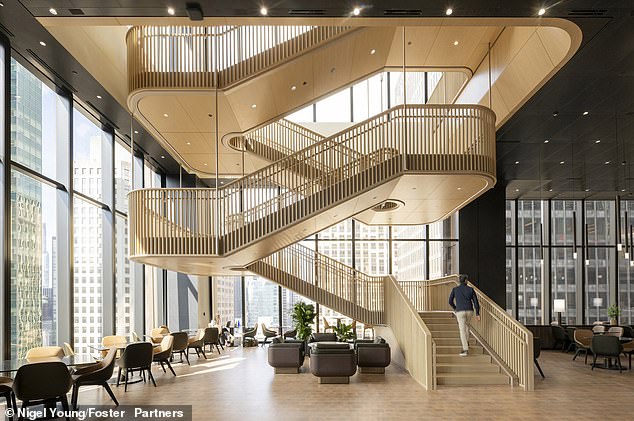
The $3 billion building, home to 10,000 workers, is designed to keep staff within the office
The new office is reportedly part of Dimon’s plan to win over reluctant returnees. In fact, Dimon was the ‘master architect,’ said David Arena, JPMorgan’s real estate boss.
Dimon – who in January marks his 20-year anniversary as CEO – gave Lord Foster the words ‘fortress’ and ‘ascendant’ to inform the design, according to the Wall Street Journal.
Dimon reportedly sees the structure as the physical embodiment of his legacy, but publicly the 225-year-old firm insists that this new temple to capitalism actually has workers’ wellbeing at its heart.
The bank boasts that 270 Park Avenue offers two times the outdoor space of their previous offices, with a gym, yoga studio and Irish pub named Morgan’s that has Guinness on tap. Dimon reportedly had to be convinced that a gym was necessary. Art work commissioned for the building adorns the walls. Lord Foster himself created ‘Wind Dance,’ a flagpole bearing the Stars and Stripes, fluttering non-stop in an artificial breeze. ‘Vibrant streetscape and outdoor amenities create a ‘city within a city’ for residents, workers, and visitors,’ the company proclaims.
Kathy Hochul, governor of New York, said at the October 21 ribbon cutting ceremony that it was so ‘incredible’ an office ‘you’re never going to want to even go home’.
And therein perhaps lies the problem.
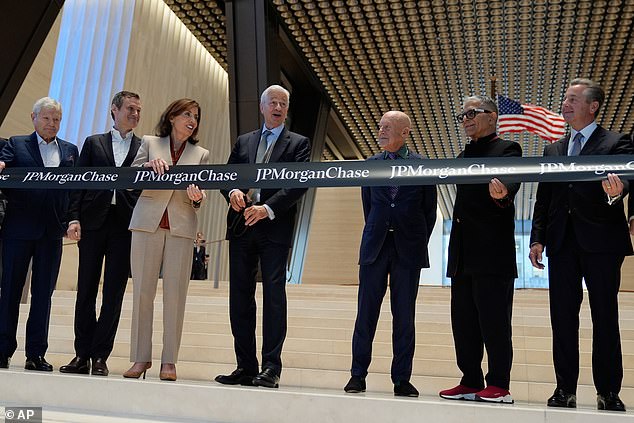
Kathy Hochul is seen next to Dimon, Lord Norman Foster, and Deepak Chopra (second right)
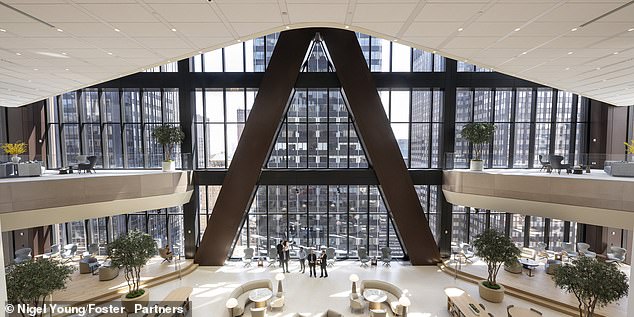
Foster Partners, the British architects of the project, worked to create a light and airy space
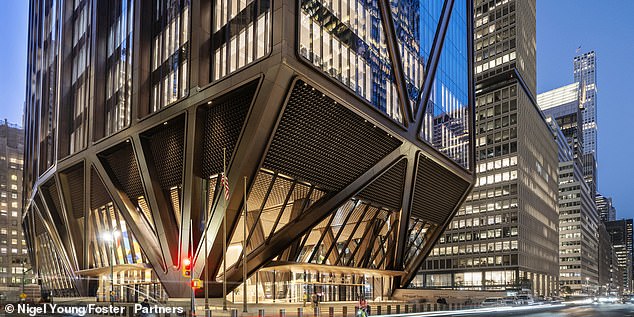
The skyscraper is perched on ‘ballerina toes’, which push the tower 80 feet above the ground
In May 2024, a 35-year-old Bank of America investment banker died from a blood clot, having told friends he was thinking about quitting due to the exhaustion of working more than 100 hours a week. Three months later a 60-year-old Wells Fargo corporate banking consultant died at her desk in their Tempe, Arizona, offices and was not found until four days later.
It’s no wonder then that JPMorgan promises that it is prioritizing wellbeing.
Deepak Chopra, the new age guru, was rolled out by JPMorgan at the opening ceremony, telling the assembled staff and dignitaries to ‘feel the quiet beneath this magnificent building, and sense the silence that gives birth to sound, to thought, to creation.’ He added, according to Puck: ‘In this stillness lies the theme of infinite prosperity.’
Yet there is no disguising the hard-headed reality behind the billion-dollar-behemoth. The days of ping pong tables, free food, bean-bag filled chillout rooms and emotional support pets seem consigned to history.
‘I don’t want AI controlling my blinds or lighting, or monitoring my work and my physical presence with my face,’ said Professor Joy Knoblauch of the University of Michigan, who studies how architecture impacts the office. ‘It is certainly dystopian, and not the direction in which I would want the world to go.’
Knoblauch, an advisor to the WELL Health-Safety Rating board, which assesses the wellbeing of occupants, said the deploying of Chopra was ‘gimmicky to some extent, because it’s public relations; it’s sentiment; it’s not particularly evidence-based.’
‘With all the automated technology inside,’ said Knoblauch, ‘they’re kind of making a cyborg worker. It’s both human and machine.’
It’s too early to tell whether the dazzling tower, perched on ballerina toes 80 feet above Park Avenue, will become a beloved icon of the Manhattan skyline.
Though the interior is already conjuring a dark future for workers.
